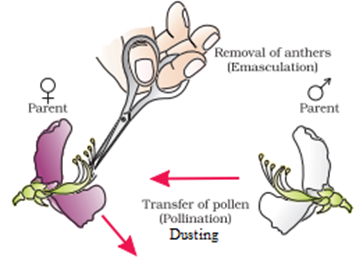Science > Biology > Genetic Basis of Inheritance > Mendel’s Dihybrid Cross Experiment
In this article, we shall study Mendel’s dihybrid cross experiment and its conclusions.
The first scientific explanation of inheritance was given by Mendel in 1866. He performed a series of experiments on garden pea in a scientific manner and proposed rules. which are called as Mendel’s Laws of Inheritance. His work is known as Mendelism. He laid down a foundation of Genetics hence he is called Father of genetics.
Dihybrid Cross (Two Factors Cross):
In an organism, there are many characters and each character is controlled by respective alleles. To study whether one pair of alleles affects or influences the inheritance pattern of a pair of other alleles, Mendel performed dihybrid cross experiments. In a dihybrid cross, he considered two traits simultaneously. Further Mendel performed trihybrid crosses and then he proposed the third law called the law of independent assortment.
A cross between two pure (homozygous) patterns in which the inheritance pattern of two contrasting characters is studied is called the dihybrid cross. It is a cross between two pure (obtained by true-breeding) parents differing in two pairs of contrasting characters.
He studied the inheritance of round and wrinkled characters of seed coat along with the yellow and green colours of seeds. He found that a cross between round yellow and wrinkled green seeds (P1) produced only round yellow seeds in the F1 generation, but in F2 generation seeds of four phenotypes were observed. Two of these phenotypes were similar to the parental combinations (yellow round and green wrinkled), while the other two were new combinations (yellow wrinkled and green round).
The Procedure of Dihybrid Cross Experiment:
Step – 1: Selection of parents and obtaining Pure lines:
For dihybrid cross, Mendel selected pea plant having yellow and round seeds (YYRR) as the female parent and pea plant having green and wrinkled (yyrr) seeds as the male parent. He obtained pure line by selfing these plants for three generations. He confirmed that pea plant having yellow and round seeds are producing yellow and round seeds and pea plant having green and wrinkled seeds are producing green and wrinkled seeds.
Step – 2: Emasculation, Dusting and Raising F1 Generation:
Emasculation:
Emasculation is a process of removal of stamens before the formation of pollen grains (anthesis). This is done in the bud condition. The bud is carefully open and all stamens (9 + 1) are removed carefully.

Dusting and Raising F1 Generation:
The pollens from the selected male flowers are dusted on the stigma of the emasculated female flower. This is an artificial cross. Mendel crossed many flowers, collected seeds and raised F1 generation. The female plant produces gametes with genes YR while male plants produced gametes with genes yr.
Yellow and round are dominant alleles, hence all F1 Generation was with yellow and round seeds. All the plants produced in F1 generation with yellow and round seeds (YyRr), which are heterozygous for both the alleles and are called dihybrid.
Punnett Square for F1 Generation:

Step – 3: Selfing of F1 hybrids to Produce F2 Generation:
Mendel allowed natural pollination in each F1 hybrid; collected seeds separately and F2 generation is obtained.
Punnett Square for F2 Generation:

Observations of the Dihybrid Cross Experiment:
Expectations:
Mendel expected the ratio of yellow and round seeds to green and wrinkled seeds to be 3:1.
Outcome:
- He found seeds of four types, yellow round, yellow wrinkled, green round and green wrinkled in the ratio 9:3:3:1.
- Out of these four types, two were parental combinations. Viz. yellow round and green wrinkled and two were new combinations like yellow wrinkled and green round.
- In all Mendelian dihybrid crosses the ratio in which four different phenotypes occurred was 9:3:3:1. This ratio is called the dihybrid ratio.
- Phenotypic ratio i.e. the ratio of the yellow round, yellow wrinkled, green round and green wrinkled in the ratio 9:3:3:1.
Mathematical Explanation of Mendel’s Law ofIndependent Assortment:
The meaning of the word assortment is ‘randomly and freely’. Thus probability theory is applicable to the dihybrid cross experiment. By the basic principle of probability, “Probability of two independent events occurring simultaneously is a product of their individual probabilities”
The probability of the first trait is 3:1 while that of the second trait is also 3:1. Thus the dihybrid ratio should be (3:1) x (3:1) = 3 x 3 : 3 x 1 : 1 x 3 : 1 x 1 i.e. 9:3:3:1 and Genotypic ratio YYRR: YYRr: YyRR: YyRr: Yyrr: Yyrr:yyRR:yyRr: yyrr is 1:2:2:4:1:2:1:2:1.
Mendel performed ample dihybrid crosses and reciprocal crosses with different combinations. Every time he got the same pattern of the result. The uniform expression was both dominant in F1 generation. In F2 generation always he got both dominant in large number.
Mendel’s Third Law of Inheritance (Law of Independent Assortment):
When two homozygous parents differing in two pairs of contrasting traits are crossed, the inheritance of one pair is independent of others. In other words, when a dihybrid (or polyhybrid) forms gametes, assortment (distribution) of alleles or different traits is independent of their original combinations in the parents. This law can be explained by help of dihybrid cross and dihybrid ratio.
It is immaterial whether both dominant characters enter the hybrid from the same or two different parents but the segregation and assortment remain the same. The appearances of new combinations prove the law. The law is universally applicable.
Importance of Mendel’s Laws:
- The concept of dominant and recessive factors is very important. This character is shown by many hereditary traits.
- It gives an idea of new combinations of traits which are very useful in developing a desirable trait in a progeny.
- This information is particularly used in the field of plant and animal breeding. Thus a new type of plants and animals can be produced by hybridization.